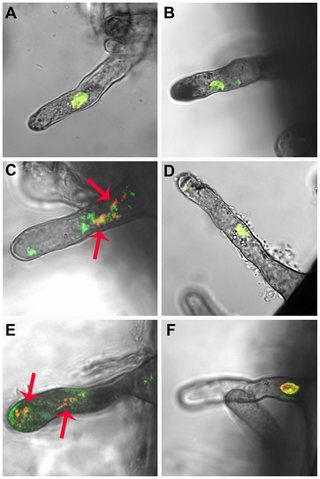Ver ítem
- xmlui.general.dspace_homeCentros e Institutos de InvestigaciónCIAP. Centro de Investigaciones AgropecuariasInstituto de Fisiología y Recursos Genéticos VegetalesArtículos científicosxmlui.ArtifactBrowser.ItemViewer.trail
- Inicio
- Centros e Institutos de Investigación
- CIAP. Centro de Investigaciones Agropecuarias
- Instituto de Fisiología y Recursos Genéticos Vegetales
- Artículos científicos
- Ver ítem
Expression of animal anti-apoptotic gene ced-9 enhances tolerance during Glycine max L.– Bradyrhizobium japonicum interaction under saline stress but reduces nodule formation
Resumen
The mechanisms by which the expression of animal cell death suppressors in economically important plants conferred enhanced stress tolerance are not fully understood. In the present work, the effect of expression of animal antiapoptotic gene Ced-9 in soybean hairy roots was evaluated under root hairs and hairy roots death-inducing stress conditions given by i) Bradyrhizobium japonicum inoculation in presence of 50 mM NaCl, and ii) severe salt stress (150
[ver mas...]
The mechanisms by which the expression of animal cell death suppressors in economically important plants conferred enhanced stress tolerance are not fully understood. In the present work, the effect of expression of animal antiapoptotic gene Ced-9 in soybean hairy roots was evaluated under root hairs and hairy roots death-inducing stress conditions given by i) Bradyrhizobium japonicum inoculation in presence of 50 mM NaCl, and ii) severe salt stress (150 mM NaCl), for 30 min and 3 h, respectively. We have determined that root hairs death induced by inoculation in presence of 50 mM NaCl showed
characteristics of ordered process, with increased ROS generation, MDA and ATP levels, whereas the cell death induced by 150 mM NaCl treatment showed non-ordered or necrotic-like characteristics. The expression of Ced-9 inhibited or at least
delayed root hairs death under these treatments. Hairy roots expressing Ced-9 had better homeostasis maintenance, preventing potassium release; increasing the ATP levels and controlling the oxidative damage avoiding the increase of
reactive oxygen species production. Even when our results demonstrate a positive effect of animal cell death suppressors in plant cell ionic and redox homeostasis under cell death-inducing conditions, its expression, contrary to expectations, drastically inhibited nodule formation even under control conditions.
[Cerrar]

Autor
Robert, German;
Muñoz, Nacira Belen;
Melchiorre, Mariana;
Sanchez, Federico;
Lascano, Hernan Ramiro;
Fecha
2014-07-27
ISSN
1932-6203
Formato
pdf
Tipo de documento
artículo
Palabras Claves
Derechos de acceso
Abierto
 Excepto donde se diga explicitamente, este item se publica bajo la siguiente descripción: Creative Commons Attribution-NonCommercial-ShareAlike 2.5 Unported (CC BY-NC-SA 2.5)
Excepto donde se diga explicitamente, este item se publica bajo la siguiente descripción: Creative Commons Attribution-NonCommercial-ShareAlike 2.5 Unported (CC BY-NC-SA 2.5)


